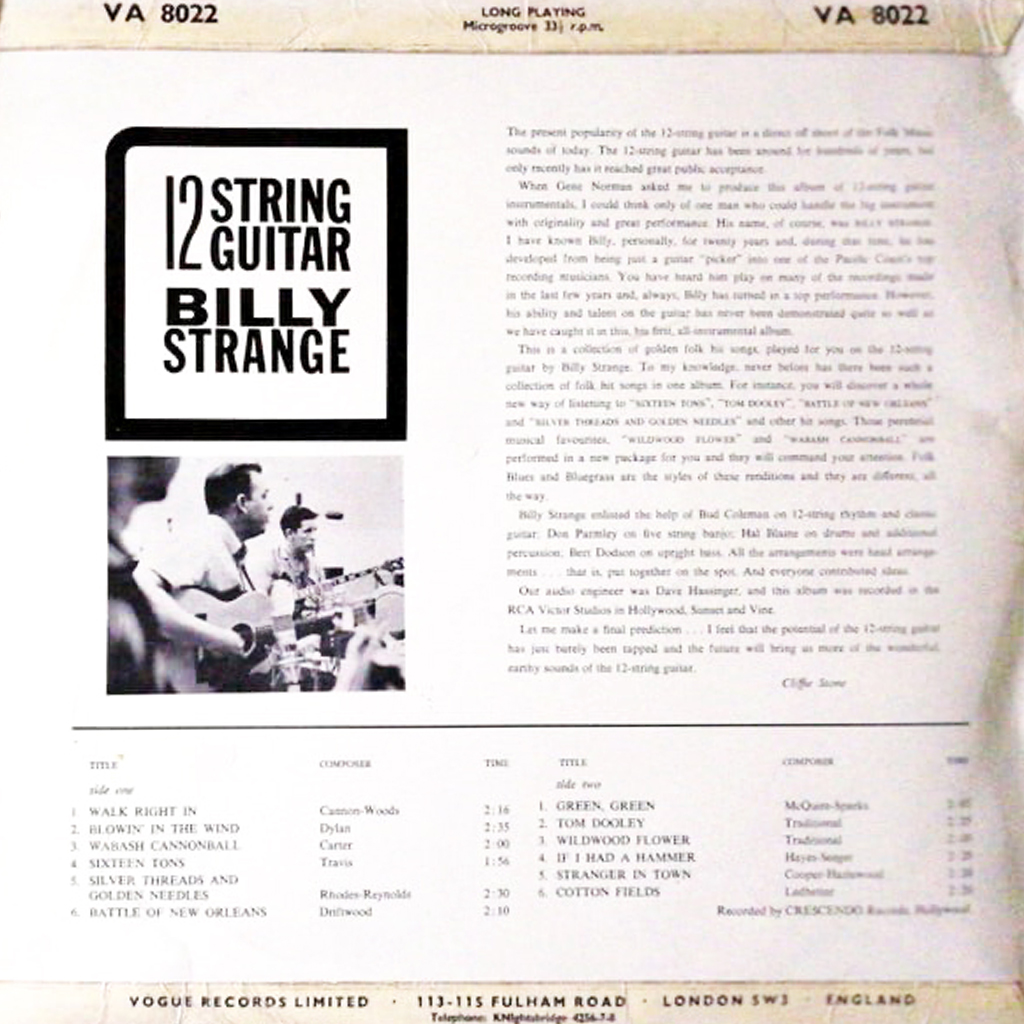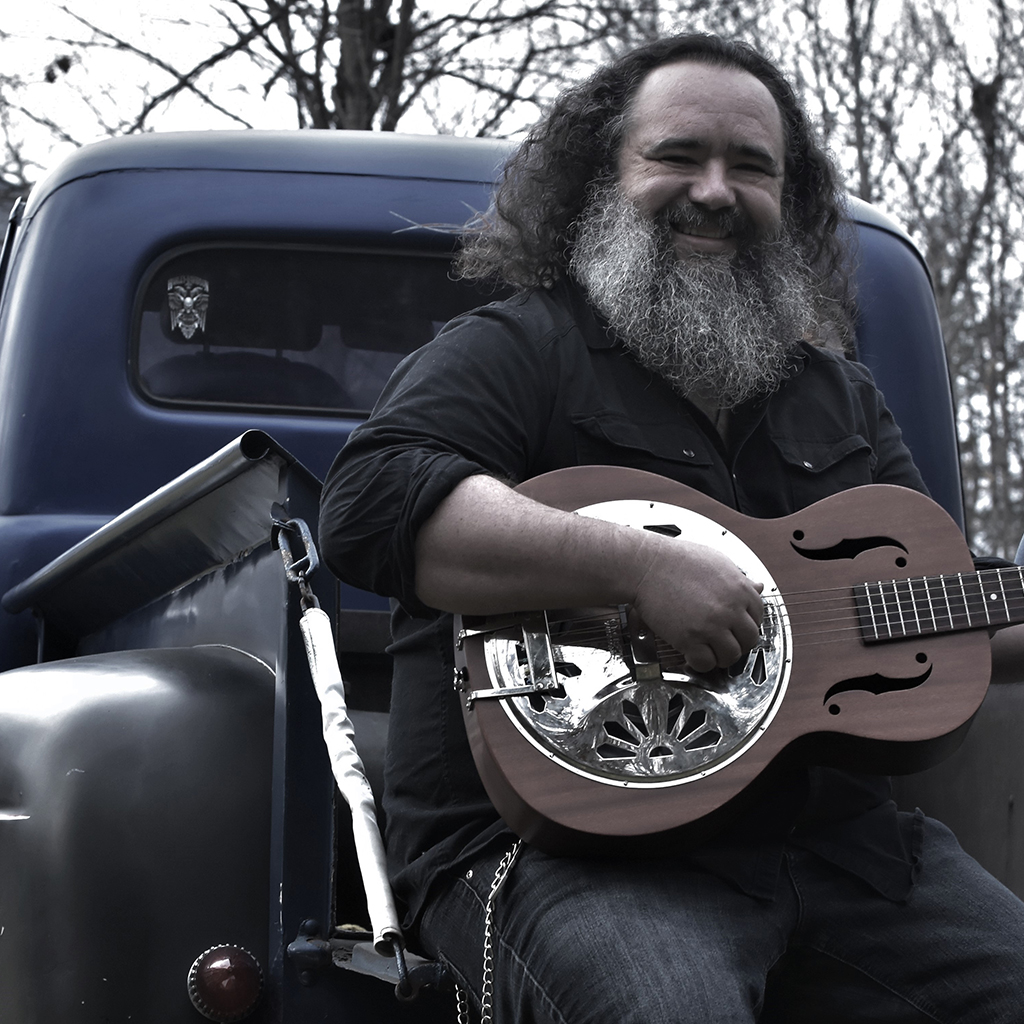
On a recent trip to San Marcos, Texas (a community about 30 minutes south of Austin), my friend, stepdaughter and I were browsing through the bins at Sundance Record Lagoon (a great little record shop; do go if you’re in the area). Among the new releases and stacks of used records, my friend discovered a particular gem: “12 String Guitar” by Billy Strange.
The cover was a “typical” 60s folk or country album cover with a picture of Mr. Strange holding his guitar, the track listing in big font and bold colours, and some photos and copy on the back of the jacket. However, it was the text on the back of the album (courtesy of Cliffe Stone) that caught our attention:
“The present popularity of the 12-string guitar is a direct offshoot of the Folk Music sounds of today. The 12-string guitar has been around for hundreds of years, but only recently has it reached great public acceptance… I feel that the potential of the 12-string guitar has just barely been tapped and the future will bring us more of the wonderful, earthy sounds of the 12-string guitar.”

Of course, we thought this is silly and absurd! Recently reached great public acceptance? Were previous players considered social pariahs? We laughed, and there was no way we were NOT getting this record.
Mr. Stone made some bold statements. So much so that I felt like digging a bit to see if there was any sense to this “absurdity”.
So, 12 strings?
For those who are unfamiliar with the instrument, a 12-string guitar looks no different from its 6-stringed counterpart. The tuning is the same (though more on that in a second), and the way the guitar is played is the same (more or less).
As far as how the instrument is set up and tuned, each string has a double (two “E” strings, two “A” strings, and so on), each double being an octave higher on the lowest four strings and tuned in unison on the highest two. The instrument is still tuned to E-A-D-G-B-E for standard tunings, but the pitches are E3 – E2 – A3 – A2 – D4 – D3 – G4 – G3 – B3 – B3 – E4 – E4 (remember that middle C is C4). Having these pairings adds additional notes in different octaves to standard chords, making them sound bigger. The sound is further widened by the slight variations in pitch between the main strings and their pairings, creating a “chorusing” effect.
You can find both electric and acoustic versions of these instruments, though acoustic versions are the ones that are seen more often.
Instruments with paired strings have existed for a long time, such as lutes and mandolins, as well as the bajo sexto and guitarra séptima from Mexico. The later instruments likely influenced the development of the 12-string guitar, which saw its beginnings in the late 19th century, eventually finding its way into folk and Latin music. So, hundreds of years? Possibly the instruments that influenced the guitar itself, though the guitar has certainly not been around for hundreds of years. Sorry Cliffe, you’re a bit off on that one.
What Came Before 12 String Guitar
The album was released in 1963, so there were only 12-string outcasts before then (supposidly). So, what came before this “seminal” album dropped?
While not outcast, there wasn’t much music being made on the instrument before then, though it was certainly associated with certain players. Probably the most famous being Huddie Ledbetter, aka Lead Belly. The 12-string guitar played just as important a part in his sound along with his voice and delivery. When it came to folk and blues, Led Belly was the real deal, as you can hear in songs such as “Goodnight Irene” and “House of the Rising Sun”.
There was also the music of Lydia Mendoza, a Tejano musician of the early 20th century. She began on bajo sexto and also played the mandolin, eventually moving to the 12-string guitar as her primary instrument. If you listen to songs such as “Mal Hombre” and “Adios Muchahos”, you can hear her beautiful and intricate work on the instrument, a contrast to Led Belly’s style, sounding no less full but giving the impression that she has a full band behind her.
Other folk and blues musicians, from Pete Seeger to Blind Willie McTell to Fred Gerlach made the instrument an important part of their sound. I’ll say that, in these cases, Cliffe is quite correct about the instrument coming from folk music.
Enter Billy Strange
12 String Guitar contains a collection of various folk and bluegrass tunes, with Billy Strange playing the melodies and comping on a 12-string guitar. He is accompanied by Bud Coleman (guitarist of Herb Alpert fame), Don Parmley (banjo player and member of The Hillmen and The Bluegrass Cardinals), Hal Blaine (legendary drummer of The Wrecking Crew), and Bert Dodson (bassist of The Cass County Boys). No slouches, that’s for sure.
According to the liner notes, the songs were “head arrangements” and performed on the spot, much like jazz musicians performing a song from a lead sheet. The music is very indicative of that, with the musicians playing off each other, improvising solos and sounding like they’re having a good time. The full album is available on YouTube.
The album itself is quite enjoyable, though to the author, does not have the makings of some legendary record that magically changed people’s perceptions of the 12-string guitar. No Wikipedia page exists (apart from a quick mention in Billy Strange’s discography), it’s not available on every streaming service, and there’s no real mention of the album having a great influence on some artists.
What we do have is the fantastic work of a great publicist who caught the attention of a couple of people at a record store in San Marcos, TX.
Should you avoid the record? Well, of course not! The arrangements are fun, the tunes are memorable (being folk and bluegrass classics, you’ll certainly recognize a few) and the whole thing makes for great listening.
What Came After
Even though this album was not some glorious and inspirational record (no “Hallelujah Chorus” was playing when the album was pulled from the bin, I can confirm), it was clear that there was a surge in the use of the 12-string guitar around the time of this album’s release. The electric 12-string guitar started being produced around 1964, with companies such as Fender Danelectro and Rickenbacker introducing various offerings. You can hear these guitars pretty extensively on The Beatles’ A Hard Day’s Night soundtrack and film (George plays a mean solo on his 12-string Rickenbacker on “I Should Have Known Better”).
Another great example is Roger McGuinn, who made the instrument an important part of the folk-rock sound of his band, The Byrds. It’s hard to imagine the sound of songs such as “Turn Turn Turn” and “Mr. Tambourine Man” without the guitar (which he ran and bought after seeing A Hard Day’s Night oddly enough).
The instrument continued to proliferate across all genres, finding its way into the hands (and songs) of bands such as The Eagles, Tom Petty and the Heartbreakers, Rush and Led Zeppelin (the latter two incorporating double-necked Gibson electrics to go from six strings to 12 strings quickly without switching instruments.) And that’s only a small sampling!
The double strings have often been seen on their own as well without their standard-tuned brethren (often called “Nashville Tuning”). This gives guitarists a layering option in the studio, adding the high jangle of a 12-string guitar to chords and single-note parts. Cue up songs such as “Free Fallin’” by Tom Petty, or “Hey You” by Pink Floyd to hear this tuning in action.
Cliffe Stone’s predictions of the future have seemed to have come true, with the instrument’s popularity taking off in the early 1960s beyond its folky beginnings. Is this a direct result of Billy Strange’s album? Probably not. Do we care? Nope!
Give 12 String Guitar a spin. It may not change the world, but you will have an enjoyable listen (and an entertaining read to boot!).
ABOUT THE AUTHOR:
“Kevin Daoust is a guitarist, guitar educator and writer based in Gatineau, Quebec, Canada. When not tracking guitars for artists around the world, or writing music-related articles around the internet, he can be seen on stage with Accordion-Funk legends Hey, Wow, the acoustic duo Chanté et Kev, as well as a hired gun guitarist around Quebec and Ontario. He holds a Bachelor of Music in Guitar Performance from Carleton University in Ottawa, Ontario, Canada.”


